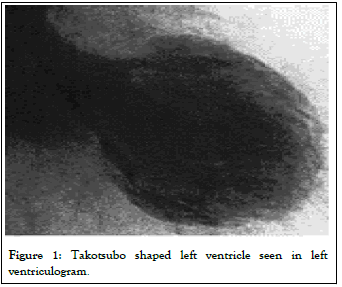Clinical & Experimental Cardiology
Open Access
ISSN: 2155-9880
ISSN: 2155-9880
Short Communication - (2023)Volume 14, Issue 12
Takotsubo Cardiomyopathy (TC) has been increasingly recognized since first described in Japan 20 years ago by Dr. Sato and co-workers in 1991. The prevalence is 1.7%-2.2% among suspected Acute Coronary Syndrome (ACS) patients and overall incidence is likely to be underestimated. It occurs mainly in postmenopausal women in the 7th-8th decades of life. It is also known as transient apical ballooning syndrome or broken heart syndrome.
Several pathogenetic mechanisms related with TC have been elucidated by authors but further studies are still warranted. These include elevated catecholamine induced myocardial metabolic impairment and stunning as an essential role [1-3]. Other multifactorial aetiologies including vascular abnormalities, oestrogen deficiency, both autonomic and central nervous system abnormalities and genetic factors play the role. Acute and reversible coronary microvascular dysfunction is a common pattern irrespective of its underlying aetiology. It often has triggers but not always. The absence of a trigger should not exclude the diagnosis.
We have recently reported a case report of TC associated with severe electrolyte abnormalities: Severe hypomagnesemia (<0.20 mmol/L) and hypocalcaemia (adjusted calcium 1.85 mg/dL) likely secondary to Omeprazole [4]. The association between electrolyte abnormalities and TC has still not been well established. Literatures advocated that electrolyte imbalances, such as hypomagnesaemia, may trigger microvascular dysfunction and hypocalcaemia may contribute to cardiac impairment. The hypothesis of PPI-related hypomagnesaemia involves inhibition of intestinal magnesium absorption. Hypomagnesemia is not only a predisposing factor for malignant ventricular arrhythmia but also directly provokes myocardial vasodilatation and indirectly affecting cardiac contractility.
Furthermore, electrolyte homeostasis is affected by neurohormonal responses to low cardiac output and by medication for heart failure [5].
The clinical presentation resembles Acute Myocardial Infarction (AMI). Early presentation signs include chest pain and Electrocardiographic (ECG) changes of ST segment elevation or T-wave inversion with or without QT prolongation. Some patients could present with dyspnoea or heart failure. Diagnostic criteria include troponin, myocardial necrosis marker release along with coronary angiography revealing no significant obstruction and Transthoracic Echocardiography (TTE) showing ventricular dysfunction with transient alterations in contraction extended beyond a single vessel territory. Apical ballooning is the most common variant. Other variants include mid ventricular, basal and focal variants. The 2008 modified Mayo Clinic diagnostic criteria suggested a pathway in focusing on TC and differential diagnoses [6].
TTE is an important investigation tool in TC not only for helping with diagnosis but also for follow-up purposes. Takotsubo shaped left ventricle will be presented in typical left ventriculogram (Figure 1). Recent study showed that the extent of perfusion defect on Myocardial Contrast Echocardiography (MCE) was transiently reduced by the infusion of adenosine and entirely resolved within a month follow up. Transient contractile recovery paralleled with improvement of perfusion, within 90 seconds from adenosine administration leading to new therapeutic targets [7]. Other helpful techniques include gated myocardial perfusion imaging, computed tomography and cardiac Magnetic Resonance Imaging (MRI) [8]. Follow up cardiac MRI usually shows improvement in left ventricular function and absence of scar on gadolinium delay enhancement images.

Figure 1: Takotsubo shaped left ventricle seen in left ventriculogram.
Emerging data supports the role of beta blockade and Angiotensin-Converting Enzyme Inhibitor (ACE-I) or angiotensin receptor blocker in addition to supportive treatment although poor scientific evidence. In addition, the role of vasodilators such as calcium channel blockers, endothelin antagonists and adenosine is likely to become well established in future trials [7]. Furthermore, electrolytes should be always checked in heart failure patients. If electrolyte abnormalities are present, the culprit should be investigated and corrected appropriately [9].
TC is an increasingly recognized condition and further clinical trials are warranted to answer unanswered questions. The annual rate of long-term mortality was 3.5% and that of recurrence was 1%. Almost all patients with TC have favourable prognosis and LV function may recover in several days and fully recuperates in 3-4 weeks.
[Crossref] [Google Scholar] [PubMed]
[Crossref] [Google Scholar] [PubMed]
[Crossref] [Google Scholar] [PubMed]
[Crossref] [Google Scholar] [PubMed]
[Crossref] [Google Scholar] [PubMed]
[Crossref] [Google Scholar] [PubMed]
Citation: Thein EKK (2023) Takotsubo Cardiomyopathy: A Brief Review on Pathogenesis, Clinical Presentation, Investigations, Management and Prognosis. J Clin Cardiolog. 14:864.
Received: 25-Oct-2023, Manuscript No. JCEC-23-27783; Editor assigned: 30-Oct-2023, Pre QC No. JCEC-23-27783 (PQ); Reviewed: 17-Nov-2023, QC No. JCEC-23-27783; Revised: 24-Nov-2023, Manuscript No. JCEC-23-27783 (R); Published: 04-Dec-2023 , DOI: 10.35248/2155-9880.23.14.864
Copyright: © 2023 Thein EKK. This is an open-access article distributed under the terms of the Creative Commons Attribution License, which permits unrestricted use, distribution, and reproduction in any medium, provided the original author and source are credited.